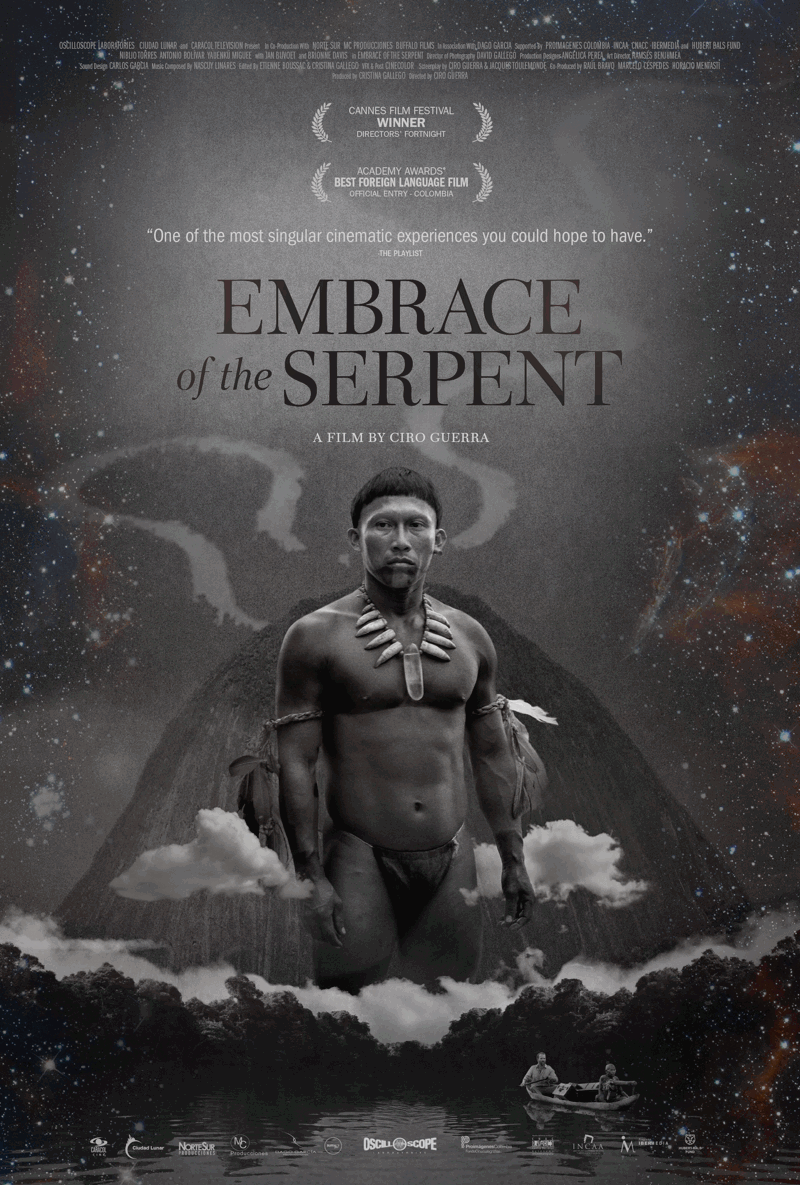The first thing that you notice is the stillness. There’s a kind of easy commingling between the vast Amazonian jungle and the film’s hero, Karamakate; their integration is so complete, it’s difficult to determine where one ends and the other begins.
In those first few moments, we’re introduced to a method of interacting with the world that is marked by both nurturing and respect, knowledge and mythology. In fact, it’s a way of connecting with nature that has shaped cultures throughout history: Before we had the means to aggressively change the world around us in order to support our fragility, we had to learn how to survive in it; and to survive in it, we developed rules and mechanisms which ultimately evolved into deeply-held beliefs about the nature of our reality, and our place within it.
 Throughout Embrace of the Serpent, we’re reminded of this seemingly essential element of humanity: Our core desire to define how and why we’re here. As Karamakate travels with the first of two Western explorers that influence his own personal journey, we’re exposed to two particularly savage methods for establishing the how and why of it all — capital and psychological colonialism. From desperate and broken rubber plantation slaves, to spiritually bereft religious missions bent on beating the civility into indigenous children, we see two very different approaches for affirming our reason for being.
Throughout Embrace of the Serpent, we’re reminded of this seemingly essential element of humanity: Our core desire to define how and why we’re here. As Karamakate travels with the first of two Western explorers that influence his own personal journey, we’re exposed to two particularly savage methods for establishing the how and why of it all — capital and psychological colonialism. From desperate and broken rubber plantation slaves, to spiritually bereft religious missions bent on beating the civility into indigenous children, we see two very different approaches for affirming our reason for being.
And as he makes the same journey with a second explorer decades later, we see how the soul-crushing methods used to validate our existence, for legitimizing our right to colonization, can result in psychological scars so deep, they transform a culture’s perspective of their unique place within the realm of existence. Their own stories, rules and mechanisms are perverted so viscerally by the colonizer’s manifest perceptions, they develop a somewhat disturbing amalgam that serves to reveal the ultimate emptiness of “meaning.”
While it’s true that our search for and attempts to establish meaning within our discrete cultures serves a crucial purpose — and is the basis on which the very structure of our societies are built, for better or for worse — when our cultures blend, and our different methods for defining the why and how diverge, we clash and struggle; we shift our focus to proving that our methods are based in veracity, and rather than continue to question, we fight for what little psychological consolation we’ve managed to carve out of the vastness of space.
But enveloping all of this humanity and its petty foibles is the vastness of the natural world; specifically within this film, the Amazon jungle. It’s like the strong arms of a parent gently holding their toddler as they cry and wail, fighting against sleep or eating or putting on pants or whatever. Our kicks bruise its shins, our flails scratch its cheek, our screams ring in its eardrums; and nonetheless it holds strong. It doesn’t give up on us, even as we’re rebelling against its needs — even its very existence — and abusing it with our wanton attitude and amorphous beliefs.
At some point in many of our world’s cultures, our collective ego emboldened us to explain the why and how by holding us above nature; a kind of clumsy divorce wherein the visitation rights have never been truly determined and we’re still living in the same house. And our practices in pursuit of this divisive why and how have served only to deepen and widen the separation between us, fooling us into believing that it’s the way of things.
While Embrace of the Serpent is equal parts road trip movie, classical hero’s journey and historical snapshot of a disappearing world, it is also a testament to the loss of our connection, on a global scale, with the planet which has shaped and nurtured us. The movie depicts historical events from the perspective of the indigenous Amazonian tribes at the turn of the 20th century, but it would be folly for us not to recognize that the spirit of these practices are alive and well today.
Until we’re able to see the structures we’ve built for exactly what they are — mechanisms for defining our world, in an attempt to survive it — we’ll continue to be divisive and disconnected. And while we’ll still be embraced by the natural world, there will be no ease in it, there will be no stillness, there will be no peace.




I appreciate the counterpoints and questions you bring up here. Helped me consider again my relationship with nature.